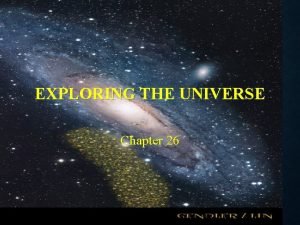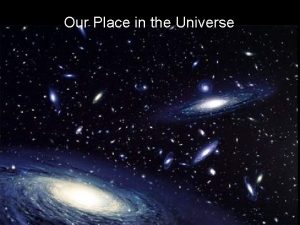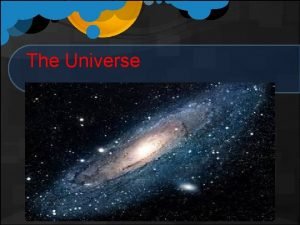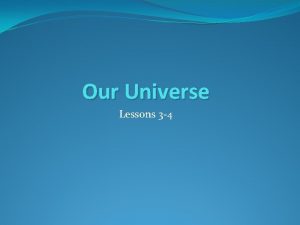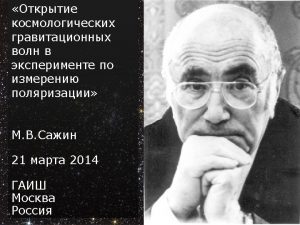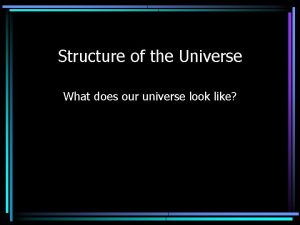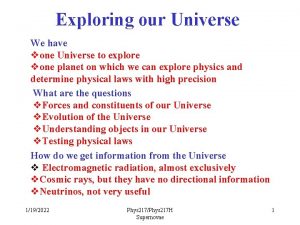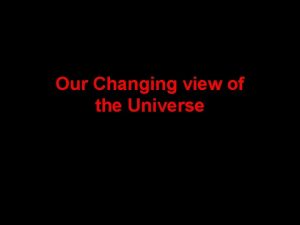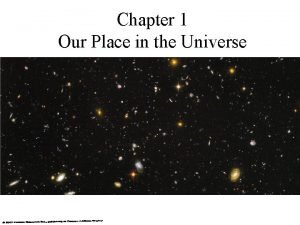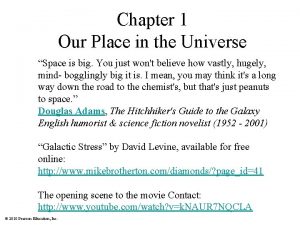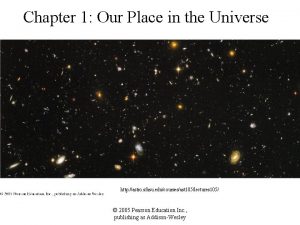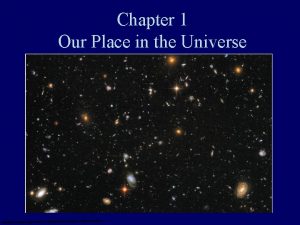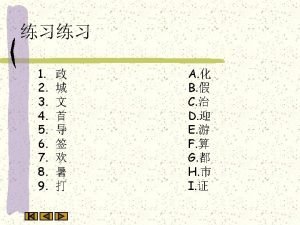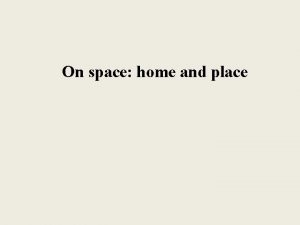Our Place in the Universe Chapter 1 The










































- Slides: 42

Our Place in the Universe (Chapter 1) The Structure and Size of the Universe

Based on Chapter 1 • This material will be useful for understanding Chapters 2, 3, and 13 on “Years, Seasons, and Months”, “The Orbits of the Planets”, and “Extrasolar Planets”

Goals for Learning • How are Earth, the solar system, and galaxies moving? • How big are Earth, the solar system, and the Universe? • How old is the Universe?

This is Earth moves Earth rotates around its axis once per day Earth also orbits around the Sun once per year

These speeds are faster than most airplanes The speed varies with latitude We don’t feel the effects of the Earth’s rotation

Play Earth rotation movie

The Earth orbits round and round the Sun at the same time that it rotates around its axis. The Earth’s axis keeps pointing at the same star in the sky as the Earth orbits the Sun. We are orbiting the Sun at 100, 000 km per hour

STOP! • Do activity on Earth’s rotation and orbit

Everything that orbits the Sun is part of the Solar System Planets Moons Asteroids Comets Some dust You and me Plus the Sun Itself This is Figure 7. 1 in the book Figure 7. 2 is shows a view from above

Orbits and Rotations of Planets • Interactive figure on “A more accurate model of the solar system” • The orbits and rotations of the planets will reappear in Chapter 7. • They are hard to display on a screen or projector • Today: Orbits of planets are very close to being in the same plane

A star shines with its own light. The Sun is a star. The Moon only reflects light from the Sun, so it is not a star. Stars are large balls of hot gas, mostly hydrogen and helium The Sun generates heat and light by a process called nuclear fusion This is different from what happens in nuclear power stations

Stars form groups called galaxies This is a fake picture of our galaxy, the Milky Way It contains 100 billion stars

The Solar System orbits the centre of the Milky Way Galaxy every 230 million years

Every object in this picture is a galaxy that contains billions of stars. The Universe contains at least 100 billion galaxies

Astronomers can measure how far away galaxies are and how fast they are moving All the galaxies in the Universe, including our Milky Way, are spreading apart and moving away from each other. Galaxies that are close together are moving apart slowly, but galaxies that are far apart are moving apart more quickly. How can this happen? The entire Universe is, for some reason, expanding. Do raisin loaf demo (fig 1. 16) Galaxies themselves are not getting larger, but the distances between galaxies are increasing

Summary • Earth rotates around its axis • Earth also orbits around the Sun • The Sun is one of many stars in our galaxy, the Milky Way • The Milky Way is one of many galaxies in the Universe • All galaxies in the Universe are moving away from each other – the Universe is expanding

Powers of Ten • 0. 00000000001 is a very small number • 100000000000 is a very large number • We will discuss very big things, like the Universe, and very small things, like atoms • We need a way to write these kinds of numbers more compactly

Powers of Ten • Rule 1: 101 = 10 • Rule 2: 10 A x 10 B = 10(A+B) • 10 x 10 = 100 • 10 x 10 = ?

Powers of Ten • Rule 1: 101 = 10 • Rule 2: 10 A x 10 B = 10(A+B) • 10 x 10 = 100 • 10 x 10 = 101 x 101 = ?

Powers of Ten • Rule 1: 101 = 10 • Rule 2: 10 A x 10 B = 10(A+B) • 10 x 10 = 100 • 10 x 10 = 101 x 101 = 10(1+1) = ?

Powers of Ten • Rule 1: 101 = 10 • Rule 2: 10 A x 10 B = 10(A+B) • 10 x 10 = 100 • 10 x 10 = 101 x 101 = 10(1+1) = 102 • So 102 = 100

Some Exercises • • 103 = ? 10000 = ? (Give answer as Power of Ten) 100 x 102 = ? (Give answer as Power of Ten) 104 x 1019 = ? (Give answer as Power of Ten)

Division • 104 / 103 = ? • 104 / 102 = ? • 104 / 101 = ? • 10 A / 10 B = 10?

Division • 104 / 103 = 101 • 104 / 102 = 100 = 102 • 104 / 101 = 1000 = 103 • 10 A / 10 B = 10(A-B)

What is 100 ? • 10 A x 10 B = 10(A+B) • 101 x 100 = 10(1+0) = 101 • 101 x ? = 101 • 10 x ? = 10

What is 10 -1? • • 10 A / 10 B = 10(A-B) 100 / 101 = 10 -1 1 / 10 = 10 -1 0. 1 = 10 -1

Some Exercises • • 0. 1 x 0. 1 = ? (Give answer as Power of Ten) 1 / 106 = ? (Give answer as Power of Ten) 102 / 104 = ? (Give answer as Power of Ten)

Summary • Rule 1: 101 = 10 • Rule 2: 10 A x 10 B = 10(A+B) • • • 102 = 10 x 10 = 100 101 = 10 100 = 1 10 -1 = 0. 1 10 -2 = 0. 1 x 0. 1 = 0. 01

The Age of the Universe • The Universe is very old • Astronomers know how far away other galaxies are • Astronomers know how quickly those galaxies are moving away from us • By comparing those distances and speeds, they can estimate how long the Universe has been expanding for Interactive Raisin Loaf • 14 billion years – The age of the Universe • The Solar System is younger. It only formed 4. 5 billion years ago

The Size of the Universe • Astronomers don’t know the size of the Universe. • We’ve never observed anything like the edge of the Universe • Without any edges, there can’t be a “centre of the Universe” • Astronomers do know that the Universe must be larger than a certain size…

The Speed of Light travels very quickly, much faster than anything else in our everyday lives. However, the Universe is so big that it takes a long time for light to travel from one galaxy to another. It takes 2. 5 million years for light from the nearby Andromeda Galaxy to reach us. If you look at the Andromeda Galaxy today, you see it as it looked 2. 5 million years ago.

Light-Years • Light travels at 300, 000 km per second • Fast enough to circle Earth 8 times every second • 1 Light-year = the distance that light can travel in 1 year • 1 light-year is about 10, 000, 000 km or 1013 km

Looking Back in Time When we look at the sky, we see nearby objects as they were a short time ago, but we see far-away objects as they were a long time ago We can’t see anything beyond 14 billion light years away from Earth, but that doesn’t mean that nothing exists that far away

Sizes of Things • Universe – 14 billion (14 x 109) light years or more • Galaxy – 105 light years • Distances between galaxies varies a lot, but can be around 100 x the typical diameter of a galaxy • There is plenty of empty space between galaxies

Sizes of Things • Galaxy – 105 light years • Closest star to the Sun – 4 light years or 4 x 1013 km • Distance from the Sun to Pluto – 0. 006 light years = 6 x 109 km • Diameter of the Sun – 7 x 105 km • You could fit 108 Suns in the distance between the Sun and its closest neighbour • There is a lot of empty space between stars (or between stellar systems) in galaxies

Sizes of Things • Distance from the Sun to Earth – 1. 5 x 108 km = 1 Astronomical Unit or 1 AU • Diameter of the Sun – 7 x 105 km • Diameter of the Earth – 6400 km • There is a lot of empty space in the Solar System between the Sun and its planets

Goals for Learning • How are Earth, the solar system, and galaxies moving? • How big are Earth, the solar system, and the Universe? • How old is the Universe?

Goals for Learning • How are Earth, the solar system, and galaxies moving? – Earth rotates on its axis once per day and orbits the Sun once each year. Earth’s axis is tilted from its orbital plane – Everything in the solar system orbits the Sun. The Sun orbits the centre of the Milky Way – Galaxies are receding from each other, so the Universe is expanding

Goals for Learning • How big are Earth, the solar system, and the Universe? – Earth is 6400 km radius and 1. 5 x 108 km from the Sun – The solar system is about 100 AU radius – Typical galaxies contain 100 billion stars and the Universe contains 100 billion galaxies – The Universe is at least 14 billion light years across

Goals for Learning • How old is the Universe? – The Universe formed 14 billion years ago in the Big Bang – The solar system formed 4. 5 billion years ago

Compressed History • The Universe is 14 billion years old. If the history of the Universe were compressed into 1 year, this is what the calendar would look like. • • 14 billion years 1. 2 billion years 270 million years 38 million years 1. 6 million years 27, 000 years 440 years -> 1 compressed year -> 1 compressed month -> 1 compressed week -> 1 compressed day -> 1 compressed hour -> 1 compressed minute -> 1 compressed second

How far is a light-year? • The Milky Way Galaxy is 100, 000 light years across. The nearest star to the Sun, Alpha Centauri, is 4 light years away. 1 light-year equals 1013 km. • If you had a ruler whose length was one of these distances, how many times would you need to lay the ruler end-to-end before you had measured out one lightyear? • • • Sun - Pluto distance = 6 x 109 km Sun - Earth distance = 1. 5 x 108 km Sun’s diameter = 1. 4 x 106 km Earth - Moon distance = 3. 8 x 105 km Earth’s diameter = 1. 2 x 104 km
 Millions billions trillions chart
Millions billions trillions chart Transfer transfer
Transfer transfer Disturbance that transfers energy from place to place
Disturbance that transfers energy from place to place Thinking language and intelligence
Thinking language and intelligence Our census our future
Our census our future Christ, be our light
Christ, be our light Marcus aurelius our life is what our thoughts make it
Marcus aurelius our life is what our thoughts make it We bow our hearts we bend our knees
We bow our hearts we bend our knees Our census our future
Our census our future Our life is what our thoughts make it
Our life is what our thoughts make it The poem money madness was published in the collection
The poem money madness was published in the collection Our awareness of ourselves and our environment
Our awareness of ourselves and our environment Is our awareness of ourselves and our environment.
Is our awareness of ourselves and our environment. God our father christ our brother
God our father christ our brother Our future is in our hands quotes
Our future is in our hands quotes Awareness of ourselves and our environment
Awareness of ourselves and our environment Awareness of ourselves and our environment
Awareness of ourselves and our environment Chapter 26 exploring the universe answers
Chapter 26 exploring the universe answers Chapter 30 galaxies and the universe
Chapter 30 galaxies and the universe Hình ảnh bộ gõ cơ thể búng tay
Hình ảnh bộ gõ cơ thể búng tay Slidetodoc
Slidetodoc Bổ thể
Bổ thể Tỉ lệ cơ thể trẻ em
Tỉ lệ cơ thể trẻ em Chó sói
Chó sói Glasgow thang điểm
Glasgow thang điểm Hát lên người ơi alleluia
Hát lên người ơi alleluia Các môn thể thao bắt đầu bằng tiếng đua
Các môn thể thao bắt đầu bằng tiếng đua Thế nào là hệ số cao nhất
Thế nào là hệ số cao nhất Các châu lục và đại dương trên thế giới
Các châu lục và đại dương trên thế giới Công của trọng lực
Công của trọng lực Trời xanh đây là của chúng ta thể thơ
Trời xanh đây là của chúng ta thể thơ Cách giải mật thư tọa độ
Cách giải mật thư tọa độ Làm thế nào để 102-1=99
Làm thế nào để 102-1=99 độ dài liên kết
độ dài liên kết Các châu lục và đại dương trên thế giới
Các châu lục và đại dương trên thế giới Thơ thất ngôn tứ tuyệt đường luật
Thơ thất ngôn tứ tuyệt đường luật Quá trình desamine hóa có thể tạo ra
Quá trình desamine hóa có thể tạo ra Một số thể thơ truyền thống
Một số thể thơ truyền thống Bàn tay mà dây bẩn
Bàn tay mà dây bẩn Vẽ hình chiếu vuông góc của vật thể sau
Vẽ hình chiếu vuông góc của vật thể sau Nguyên nhân của sự mỏi cơ sinh 8
Nguyên nhân của sự mỏi cơ sinh 8 đặc điểm cơ thể của người tối cổ
đặc điểm cơ thể của người tối cổ Thứ tự các dấu thăng giáng ở hóa biểu
Thứ tự các dấu thăng giáng ở hóa biểu

















